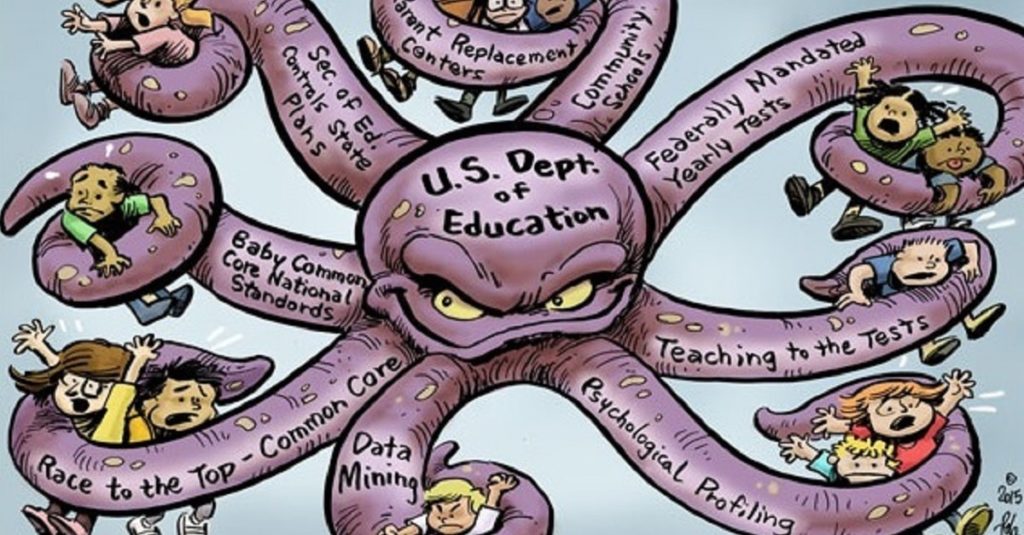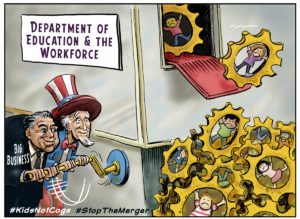President Trump’s 2020 Budget: The Good and Bad News for Education
This article written by Dr. Karen Effrem for The National Pulse lays out and simplifies this year’s education budget proposals.
As discussed for the last two budget cycles (here and here) President Trump is working to keep his 2016 campaign promise to cut the size and scope of the U.S. Department of Education (USED). Here is some of the good, bad and ugly of the Fiscal Year 2020 budget:
The Good News
The 2020 budget seeks to cut overall USED spending by $7.1 billion or ten percent. That is consistent with his previous budgets and a good start on what is a big job. Basically level funding is maintained for both Title I, the main federal education program for poor students in the Every Student Succeeds Act (ESSA), and for the Individuals with Disabilities Act.
Within that 10 percent, for a total of $6.7 billion, the proposed budget eliminates “funding for 29 programs that do not address national needs, duplicate other programs, are ineffective, or are more appropriately supported with State, local, or private funds.”
Among those 29 programs proposed for elimination are several that we have followed over the years that are particularly invasive:
Full Service Community Schools — a.k.a. Parent Replacement Centers
21st Century Community Learning Centers — Besides being terribly ineffective, according to a national study performed by USED, there is evidence that these programs are actually harmful to behavior.
Safe and Supportive Schools Program — This $1.17 billion program is new since ESSA was passed in 2015 and contains many social and emotional learning programs with all of their subjectivity and data collection with the potential to live forever in the state longitudinal systems (SLDS), whether the data is accurate or not.
State Longitudinal Data Systems — Given the porousness of student data protections due to the age and weakness of the Family Educational Rights and Privacy Act (FERPA) already with rampant sharing of very sensitive student and family data, including SEL data, with government agencies, corporations, and researchers, all without parental consent, this is possibly the best cut on the list.
The Institute for Education Sciences (IES) that oversees the SLDS and all other federal education data mining is taking a 15 percent cut in this budget.
As it did last year, the budget request zeroes out the $250 million Preschool Development Grants. Given the near constant stream of data from the federal government or scholarly sources, even to the left of center, showing government preschool to be at best, ineffective, and at worst harmful, this is a very wise move.
Regional Education Laboratories — These education research centers have long been petri dishes for failed progressive policies that, as admitted by the head of one regional lab back in 1989, are seeking “…the total restructuring of society…”
Ready to Learn Television — This is further government supplementation of public broadcasting, which is already biased toward the left end of the political spectrum to produce government approved children’s programming that has contained many topics controversial among adults.
The Bad (or Less than Ideal) News
There is a push to use the savings from the eliminated or reduced funding to promote public and private school choice, a big priority for both the President and Secretary DeVos — but which has detractors on all points on the political spectrum. The significant problems with federal school choice from a conservative perspective, particularly the strong potential for imposing state tests and therefore the state standards, were discussed by Joy Pullman at The Federalist and by me a few weeks ago.
The budget calls for $53.4 million for school climate grants, including tiered programs like Positive Behavioral Interventions and Supports (PBIS), that begins with monitoring the attitudes and behaviors of the entire student population and advances toward intensified “interventions” as the staff determines children need more “help.” PBIS was originally included in the Individuals with Disabilities Education Act (IDEA) to try to resolve academic or mental/SEL issues of “at-risk” students short of a full special-education referral, but ESSA expanded the program school-wide. Despite claims by proponents that PBIS is “evidence based” or “research based,” the federal PBIS technical support center admits that “school-wide PBIS is in its infancy” and that all of PBIS is quite experimental. In other words, there are no controlled trials involving large numbers of students to know if the concept really works. Nevertheless, PBIS is embraced uncritically in the public-education realm; even the federal School Safety Commission has recommended it as a means to prevent school violence. The literature on PBIS includes little to no discussion of how the universal or at-risk behaviors are chosen; what sensitive, personally identifiable information is collected on children for the various tiers; how children’s attitudes, values, and beliefs are modified; and what outcome data is included in children’s lifelong data dossiers (more about this below). Also, the phrase “parental consent” rarely, if ever, appears on PBIS explanatory websites.
The Bottom Line
Unfortunately for the great cuts in this budget and fortunately for the bad items, if Congress, even under total Republican control, was unable or unwilling to pass most of the President’s budget request, it is highly unlikely to happen now, given that Democrats control the U.S. House. However, with the 2020 elections upcoming, there is a chance that if we unite, we can make our voices heard on these vital issues of academic excellence, parental autonomy, and privacy. Stay tuned!
The full article can be found on The National Pulse’s website.
Does America Really Want a Federalized School Choice Program?
This article written by Dr. Karen Effrem for The National Pulse explores how school choice might be rolled out on a federal scale.
During last week’s State of the Union speech, President Trump spoke briefly on education by stating, “To help support working parents, the time has come to pass school choice for America’s children.” This may include Senator Ted Cruz’s Student Empowerment Act, which would expand tax-free 529 college savings plans to include K-12 education expenses for public, private, religious, and home education.
While appreciating this concern and compassion for poor and underserved children who need a good education, there are many dangers with a school choice program, especially at the federal level. The biggest and most obvious concern is the further expansion of unconstitutional federal control in education. Imposition of federal regulations on private, home, and charter schools would naturally follow federal funds. Despite claims by proponents that the 2015 federal education law, the Every Student Succeeds Act (ESSA), returns education control to the states, nothing could be farther from the truth. The myriad and byzantine stipulations and regulations of ESSA would be enough to destroy private and home school autonomy for good.
Requirement of the statewide tests that measure the statewide standards — which for 41 states is still Common Core — is the worst of these. I began writing about this major concern in 2012. That was the year presidential candidate Mitt Romney, in an education plan written or heavily influenced by Jeb Bush, promoted Title I portability with federal funds but requiring the state tests. The damage to private school autonomy in state school choice laws that required the state Common Core tests was also noted. The late conservative icon Phyllis Schlafly, founder of Eagle Forum also clearly understood this danger when she said:
“The Obama Core advocates are even planning to impose their standards on private schools. As the school choice movement grows, the attempt will be made to force any private or charter school that accepts public funds to adopt Common Core standards and have their students take the national tests.”
Conservative firebrand Michelle Malkin also cogently grasps the issue, writing the following:
“Big-government Republicans such as Jeb Bush and flip-flopping Mike Huckabee pay lip service to increasing school choice and supporting charter schools, private schools and homeschooling. Yet, they have been among the loudest GOP peddlers of the Common Core “standards”/textbook/testing/data collection regime thrust upon schools who want nothing to do with it. … No fully funded school voucher system in the world can improve the educational experience if Fed Ed controls the classroom and homeschool room. Coerced conformity kills choice.”
The full article can be viewed at The National Pulse’s website.
Townhall – Lame-Duck Congress Plays Grinch to Citizens by Passing Anti-Privacy Database Bill
In a new column at Townhall.com, Dr. Effrem explains the dangers of the unrecorded voice vote passage of yet another privacy invading bill by the U.S. Senate, waiting until after the election to pass a bill that dozens of citizen and parent groups opposed when passed by the House in 2017. This excerpt discusses some of the many reasons HR 4174, the Foundations for Evidence-based Policymaking Act (FEPA) is so problematic based on a summary and a rebuttal prepared by groups opposing FEPA:
While FEPA itself doesn’t expressly establish a formal data system with a central repository, the bill’s mandates regarding linking and sharing data among multiple federal agencies and thousands of bureaucrats will create essentially the same result: a de facto national database.
The federal government is demonstrably incompetent at data security; moreover, it routinely ignores the overwhelming data it already has showing the ineffectiveness of many (most) federal programs. There is no reason to believe an even more enormous trove of data can be secured, or that it will actually change government behavior in any meaningful way.
Most importantly, collecting and holding massive amounts of data about an individual has an intimidating effect on the individual—even if the data is never used. This fundamentally changes the relationship between the individual and government. Citizen direction of government cannot happen when government sits in a position of intimidation of the individual.
The full commentary is available HERE and has also been discussed at Breitbart.com and EdWeek.org.
Due to the partial government shutdown, the White House comment line is not operating, but you may urge President Trump to veto this egregious violation of citizen led-governance and privacy by emailing him or tweeting to @realDonaldTrump or @POTUS.
Truth in American Education – Is American Government Rejecting Capitalism & Embracing a Managed Economy?
Because this trend towards a managed economy is so concerning, Dr. Effrem’s article from Truth in American Education is re-posted here in its entirety.
While skilled workers are needed to build new infrastructure and for our expanding economy after the tax cuts, the reauthorization of the Carl Perkins Career and Technical Education (CTE) Act of 2006 tries to accomplish those goals via the wrong method – replacing capitalism with central planning. The new bill, called The Strengthening Career and Technical Education for the 21st Century Act, HR 2353, just passed Congress on voice votes and signed yesterday.
The increasingly centralized federal education and workforce system, of which Perkins is a part, is multifaceted: the Every Student Succeeds Act, the Workforce Innovation and Opportunity Act (WIOA), the proposed merger of the Departments of Labor and Education, Common Core for use with digital badges, computerized “personalized” learning (PL)/competency-based education (CBE), and older laws like No Child Left Behind, Goals 2000, and School to Work.
This longstanding, unconstitutional federal interference in education and labor markets, picking winners and losers, has not improved and will not improve academic or economic outcomes. Even worse, Perkins is the latest example of racing away from capitalism to embrace principles of government/corporate control found in European social democracies and failed command-and-control economies littering the 20th century.
The Perkins reauthorization contains multiple passages embracing central economic planning. The bill requires the use of “State, regional, or local labor market data to determine alignment of eligible recipients’ programs of study to the needs of the State, regional, or local economy, including in-demand industry sectors and occupations identified by the State board, and to align career and technical education with such needs…” What happened to individual students and free markets making those decisions?
The “State board” refers to government-appointed bureaucrats, including corporate bigwigs, on state workforce boards set up under the Workforce Investment Act (predecessor to WIOA) signed by President Clinton. This scheme elevates the needs of business over student desires, while playing Carnac to predict economic trends.
These boards were essential to Marc Tucker’s plan to centralize the entire U.S. education and workforce system, outlined in his now infamous 1992 letter to the Clintons. It was and remains Tucker’s plan to “to remold the entire American system” into “a seamless web that literally extends from cradle to grave and is the same system for everyone,” coordinated by “a system of labor market boards at the local, state and federal levels” where curriculum, including “national standards” and “job matching,” will be handled by counselors “accessing the integrated computer-based program.”
In 2001, former Congresswoman Michele Bachmann and policy analyst Michael Chapman described key components of Tucker’s system implemented via three federal laws signed by Clinton, including: Continue reading »
Issues
- Assessments + Testing (25)
- Bullying/Sex Education (6)
- Child Protection League (2)
- Common Core Standards (78)
- Curriculum + Standards (65)
- Data Collection and Data Privacy (64)
- Early Education/Nanny State (75)
- Federal Education (128)
- International Education (6)
- LGBT Issues in Education (9)
- Media Appearances (4)
- PL/CBE (2)
- Planned Economy (11)
- Politics of Education (26)
- School Violence (9)
- Social Emotional Learning/Mental Health (52)
- State Education (89)
- Testimony/Presentations (17)
- Uncategorized (13)
- Unions (10)
Education Liberty Watch Projects
ELW Allies
- American Principles Project
- Cato Institute
- Conservative Teachers of America
- Constitutional Coalition
- Eagle Forum
- Minnesota Advocates and Champions for Children
- Missouri Education Watchdog
- Restore Oklahoma Parent Empowerment
- Stop Common Core
- The Pioneer Institute
- Truth in American Education
- What is Common Core – Education Without Representation



